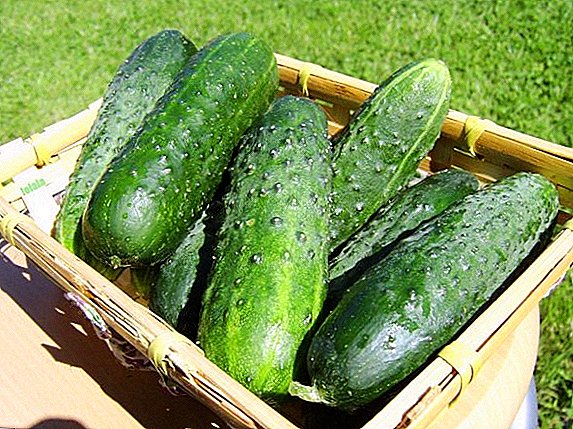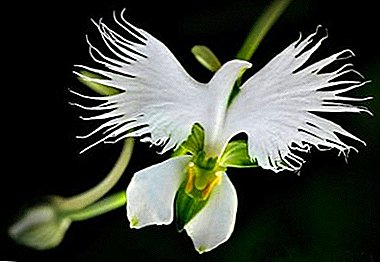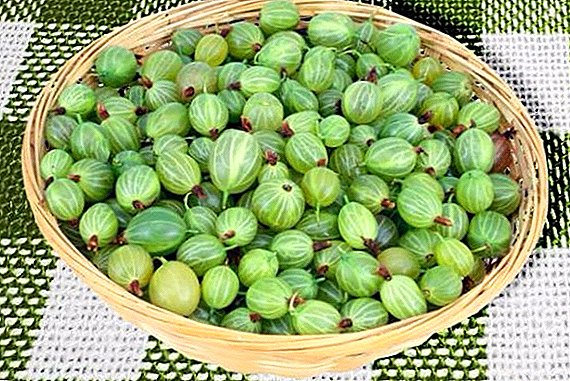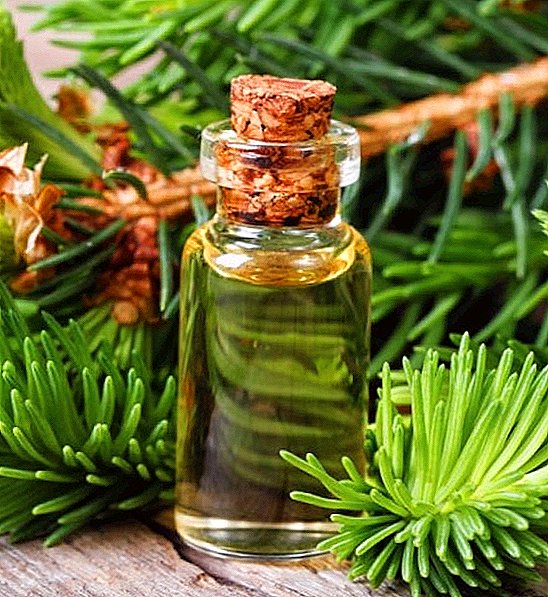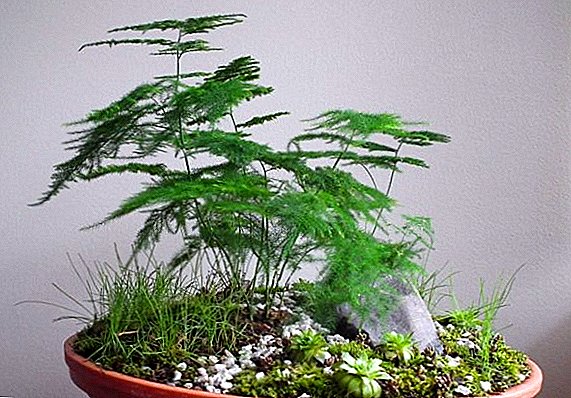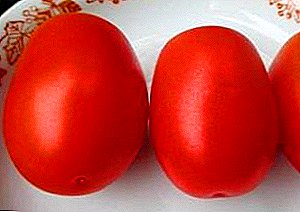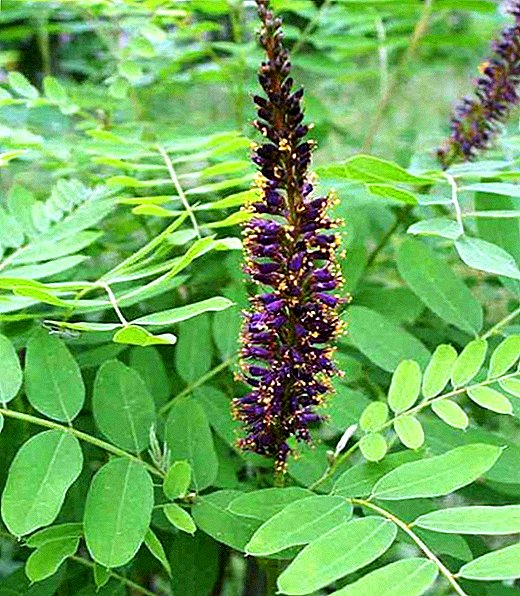 In modern landscape design in recent times there are plants that have an attractive shape, interesting appearance, but at the same time, unpretentious and hardy. One of these plants is shrub amorpha. It is still not very familiar to our domestic gardeners, but among foreign experts this plant is a real star.
In modern landscape design in recent times there are plants that have an attractive shape, interesting appearance, but at the same time, unpretentious and hardy. One of these plants is shrub amorpha. It is still not very familiar to our domestic gardeners, but among foreign experts this plant is a real star.
Botanical description
Bush amorpha (lat. Amórpha fruticósa) belongs to the shrubs of the legume family. Plant height can reach 1-2 meters, sometimes higher.
The legume family has more than 20 thousand species, including traditionally beans, peas, peanuts, caragana, alfalfa, beans, clover, lupine, dolichos, broom, meadow and clitoria.
The branches are thin, directed upwards, with brown or dark gray bark, on which short white hairs can be found. The leaves are long (up to 20 cm), pinnate, leaf plates in the amount of from 5 to 12 pieces are located on the petiole and have the shape of an elongated oval.
The flowering period of this shrub begins in mid-June. Small flowers of different shades of purple with yellow stamen are collected in the inflorescence in the form of an ear.  The inflorescences are located on the young shoots vertically upwards, reach a length of 15 cm and exude a vanilla flavor.
The inflorescences are located on the young shoots vertically upwards, reach a length of 15 cm and exude a vanilla flavor.
Fruits ripen in September and are small curled beans up to 10 mm long and up to 2 mm wide. They do not open and can remain on the branches until spring.
Kinds
Shrubby amorpha as a base species has several varieties, namely:
- weeping "pendula" - with hanging branches;
- white "Albiflora";
- large-flowered variety "Lewisii";
- Blue-flowered variety "Soerlea";
- narrow-leaved variety "Angustifolia";
- elegant "Tennessensis";
- Crispa variety - has curly leaves with a wavy edge.
Did you know? Amorph shrub - beautiful honey plant, which can give from 50 to 100 kg of honey per hectare. If you have such a plant on the site, then you will receive not only aesthetic pleasure, but also attract bees to visit.
Breeding
This shrub is successfully propagated by dividing the maternal shrub, as well as using seeds and cuttings. Let's take a closer look at each method.
Cuttings
Cuttings are recommended to be harvested from the beginning of June, having previously prepared a place for planting. These can be pots of suitable size with a light nutrient soil mixture, at the bottom of which drainage is laid.
For grafting choose stronger branches, which already have at least five sheets. Immediately after cutting, place the cuttings in the soil and be sure to cover it with a glass jar. Humidity should be moderate, but constant.
The stem rooted in this way lives in a pot for a whole year until spring; in winter, the plant is best placed in a room where it is dry, dark and cool.  After the soil has warmed up under the spring sun, you need to plant a young seedling for permanent residence in your garden. The place should be sunny, without stagnant water.
After the soil has warmed up under the spring sun, you need to plant a young seedling for permanent residence in your garden. The place should be sunny, without stagnant water.
Replanting should be done very carefully, with a lump of earth, so as not to damage the roots. The first time is very important in time to moisten the soil around the young plant.
Seeds
The shrub we are considering is not difficult to get from the seeds.
Important! Seeds for planting are in the shell of a tiny bean that does not need to be opened when planted. The beans are so small that one thousand beans weighs only 6-13 grams.
We must begin in the spring, in March - early April. It is necessary to prepare in advance containers with high-quality soil and with good drainage. Then soak the seeds in water for 10-12 hours. Water should be clean and at a temperature of 22-24 degrees.
After this, the soil for planting should be well moistened and seeds planted into it, shallowly embedded. For successful germination, a temperature regime of 20 degrees and constant, but moderate humidity are necessary.
When on the seedling real leaves appear stronger, pick up in suitable pots. And throughout the year, young amorphs will be in pots to gain strength.  Seeds of amorphs In the warm season, it is better to bring the pots to the garden plot, but before the cold they must be brought home and put where there is a little light, dry and cool.
Seeds of amorphs In the warm season, it is better to bring the pots to the garden plot, but before the cold they must be brought home and put where there is a little light, dry and cool.
The next year, immediately after the soil warms up, plant the strengthened seedlings into the ground. Recommendations for planting are the same as for seedlings grown from cuttings.
Dividing bush
This method of reproduction is not only the easiest, but also productive. You just need to follow some rules.
Important! It is possible to divide an adult amorph only in spring, otherwise a young bush will not have time to take root and grow..
So, choose a strong shrub with a sufficient number of basal shoots. Young shoots need to be separated carefully, very carefully digging the ground, so as not to damage the adult plant.
A place for planting must be selected taking into account the light-loving nature of the plant; the soil must be loose and permeable. Planting pits with a depth commensurate with the length of the young shoots must be made in advance.  Intermediate landing is not needed, so immediately plant young in the prepared place.
Intermediate landing is not needed, so immediately plant young in the prepared place.
Do not forget about the light constant soil moisture around the transplanted bush, until it grows. Further watering is moderate.
Plant Care
Shrub amorpha refers to plants that require a minimum of care. Therefore, it may be of interest to gardeners who do not have a lot of free time. Consider recommendations for care.
The soil
In order for our bush to develop well, it is necessary, especially in the first three years, to mulch the soil around it. Peat, wood ash can be used for this. This will keep the soil from drying out.
For an adult bush, this technique can not be used, according to your desire. But to loosen the soil in pristvolnom circle need a couple of times during the warm season.
Read more about different types of soil, fertilizer systems for them, and also learn how you can improve soil fertility.
In general, it should be noted that the bush amorpha is not at all demanding on the soil, it will grow in any soil. But still with regular loosening and mulching, the bush will delight you with its excellent look. 
Watering
Watering the plants practically will not take up your precious time, because the bush successfully endures even drought. If there is no rain for a long time, then pour it a couple of times a month, but do not fill it.
Humidity
Constant soil moisture around the plant is important only in the first year of planting in open ground, when the bush takes root and is actively growing. In the future, this is not necessary, and stagnation of water should be avoided.
Top dressing
It is not necessary to fertilize a shrub if the land in which it grows was originally fertile enough. But if you planted an amorph in a depleted soil, then in five years it is better to feed it.
To do this, in early spring, scatter the complex mineral fertilizers around and slightly close them up in the soil.
Familiarize yourself with the use of such mineral fertilizers as: Plantafol, Sudarushka, Azofoska, Kristalon, Ammophos, Kemira and Master.
Also in the spring you can make and organic fertilizers, prikopav them around the rim of the circle. One feeding per year will be quite enough.
Pruning
Pruning is the only strict procedure in the care of our bush.  Three points are worth considering:
Three points are worth considering:
- each spring, you should cut off sanitary pruning, that is, cut out all the old, frozen, damaged branches;
- if your shrub grows poorly, then to activate and rejuvenate it, use full spring pruning at the root. Surprisingly, young shoots will grow back in the same season and will delight you with flowering;
- pruning of all excess root shoots is also recommended.
Bending down
If you live in the middle lane, it is best to prepare an amorphous bush for the cold. To do this, gently bend the branches of the plant to the ground, secure. As a shelter, use coniferous spruce branches, dry foliage or special agrofibre.
Important! Consider the fact that when the air temperature is below 20 degrees of frost, the shoots of amorphus die and even the root system may suffer.
Use in landscape design
This plant has a good decorative effect and is successfully used by experts in different conditions, namely:
- as a single shrub with original appearance;
- to draw attention to flowerbeds, stone gardens and other landscape compositions;
- as a hedge;
- as vegetable figures of different forms, as well as amenable to shearing;
- to create landscape compositions in areas with slopes, which also strengthens the soil;
- as a companion for large cereal crops and other shrubs.
Difficulties in growing
Shrub amorpha refers to plants that do not need special care and care. But still some difficulties may appear, especially when the plant is young.  Young bush needs special attention, especially in the first year of life. Be sure to irrigate as needed after planting in the ground, otherwise it dries. Also, carefully close the plant for the winter, because even a slight frost can ruin immature branches and roots.
Young bush needs special attention, especially in the first year of life. Be sure to irrigate as needed after planting in the ground, otherwise it dries. Also, carefully close the plant for the winter, because even a slight frost can ruin immature branches and roots.
In an adult plant, the care problems are much less, but be sure to watch out for unnecessary root shoots, otherwise it will be very difficult to cope with the seedlings. Beauty and harmony will break in your favorite garden.
Important! Shrub amorpha does not tolerate repeated transplants at all, so think carefully about the landscape composition before you plant a bush in the garden.
Such a challenge as collecting your own seeds can cause difficulty. The fact is that in our natural environment, they rarely mature. Therefore, it is better to buy ready-made seeds. Also, when taking care, keep in mind that the plant is poisonous.
Diseases and pests
According to experienced gardeners, bush amorphous, surprisingly, is not subject to diseases and pests. She does not even need a prophylactic treatment against fungal infections and aphids.
Now you have the necessary information to become interested in such an unusual plant as a bush amorph. And if you decide to plant it in your garden, our advice and recommendations will be very helpful. Good luck to you in any garden endeavors and experiments! 



